home |
electronics |
toolbox |
science club |
tuxtalk |
photos |
e-cards |
online-shop

Adapting a USB sound card to work with a studio condenser mic
Neewer is a Chinese brand for good quality affordable audio equipment. Their condenser microphones
NW-700 and NW-800 are reasonably priced and really good. Those are cardioid-directional low noise
microphones with a wide dynamic range and they can compete in sound quality with
professional microphones. It's possible to get this microphone to work really well with a simple USB sound card.
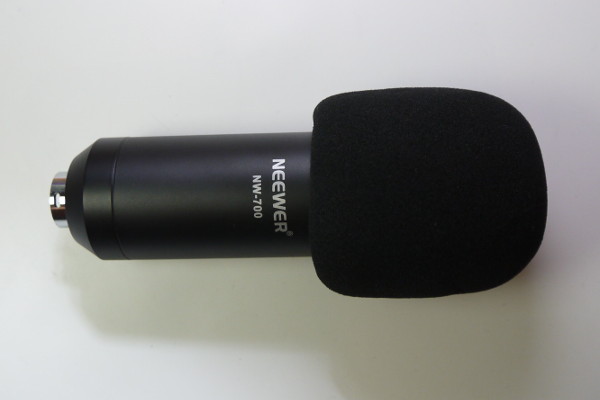

Condenser microphones need a power supply to function. Almost all computer microphones
are condenser microphones and your PC provides about 2.5V to 3V DC via a 3KOhm resistor on it's
Mic port. Those 3V are good enough for the typical small headset microphones and other
computer gadgets. The problem is that the Neewer NW-700 needs a higher voltage. The
NW-700 will work a bit with the 3V but the volume will be very low. It does just not work
properly with so little power. Professional
studio condenser microphones are powered by a 48V DC phantom power supply. It's box
with it's own power supply and you put it in line with the microphone. It's the same
concept as the 3V from the sound card just much more juice. The NW-700 can work with
such a phantom power supply.
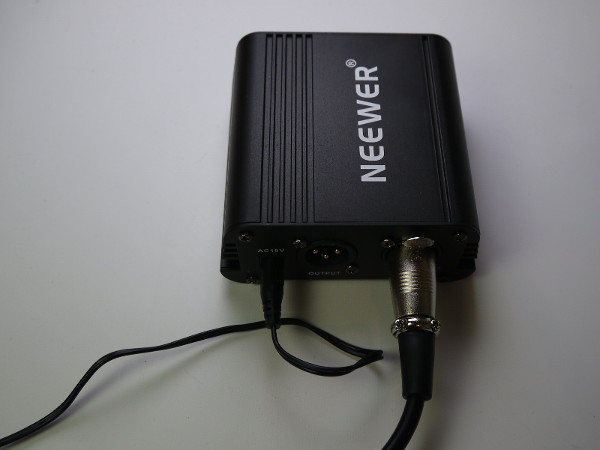
The problem is that this setup is bulky. It's OK for a studio setting where things are installed
permanently but it does not work well if you want to carry a NW-700 together with your
laptop. It's possible to buy overpriced portable battery powered phantom
power supplies but there is a much better solution: Modify a small USB sound card.
If you read the data-sheet of the NW-700 then you will find that it can actually already
work properly with just under 5V DC.
The soundblaster cards and today's sound cards
Creative Labs soundblaster cards were very popular cards in 1990's and they came up with
the idea of a small bias voltage to power the microphones. The connectors where 3.5mm and
had 3 connections for a single Mono Mic: 1(tip)=signal, 2(ring)=5V bias voltage, 3(sleeve)=Ground.
Today's sound cards continued the idea of bias power but they work with only 2 wires (still same connector) and about 3V bias voltage.
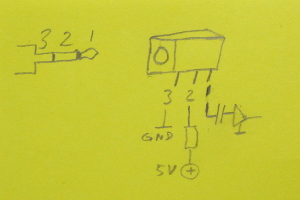
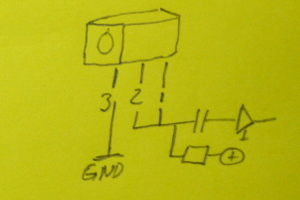
Left: how it used to be in the soundblaster cards, Right: what you will find in today's cards (especially small USB sound cards)
A USB sound card that provides 5V DC to the mic
I bought on ebay a USB sound card that looked like it might still have space in it's enclosure
for a few extra components:
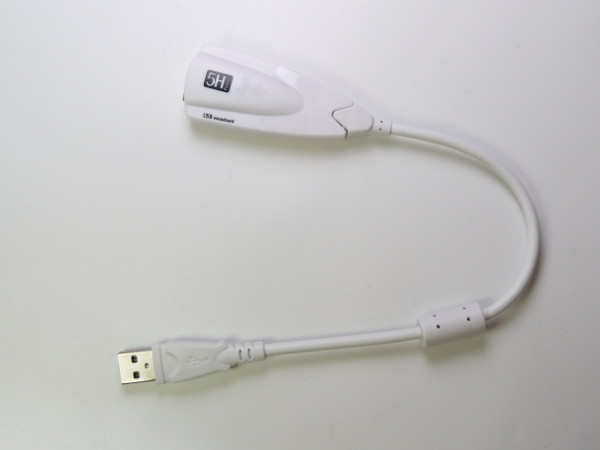
Any USB sound card looks internally basically like this:
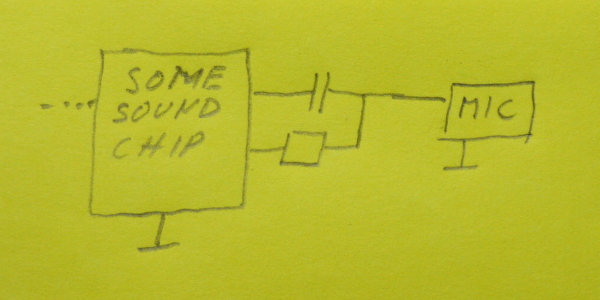
A sound chip provides about 2.5V to 3V DC via a 3 KOhm resistor to the microphone port. There is as well a capacitor connected to the mic port to separate the audio signal from the DC voltage.
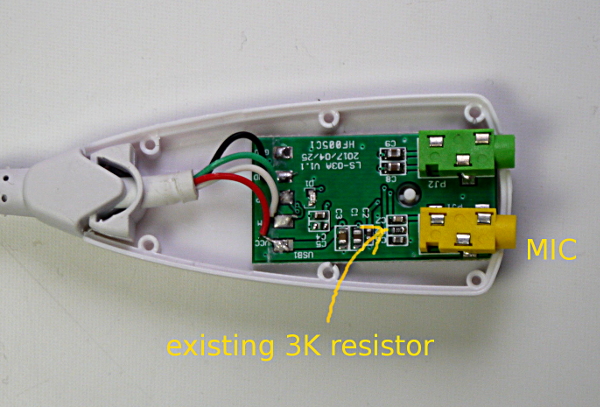
A Ohmmeter is useful for locating the correct resistor. This card had actually only one resistor. The other
components are a LED and capacitors.
What we need to do: remove the existing resistor and add a new one that connects
to noise free 5V DC. USB offers 5V DC but there might be some noise so we add a small
low pass filter (270 Ohm resistor + 10μF capacitor). Like this:
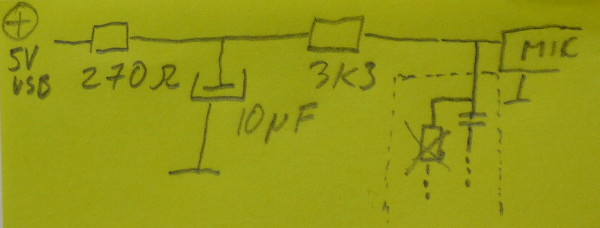
The components in the dotted box are the ones that were already on the usb sound card and we remove
the resistor.
List of required components:
- 3K3 resistor (or unsolder existing 3K resistor and re-use it if you are good at soldering).
- 10μF or 22μF electrolytic capacitor. Watch out for correct polarity. I recommend an
SMD capacitor because there is not much space on the board.
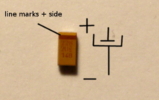
- 270 Ohm resistor (as small as possible).
I opened the casing of the sound card by prying it open with a knife and then I soldered the extra
components to the board. The brown box in the corner is the 10μF electrolytic capacitor (belly up). You notice
that there is a green LED and an extra resistor in the middle. This sound card had an annoying bright
red LED that was blinking all the time. I replaced it by a green one and dimmed it down with the extra
resistor.
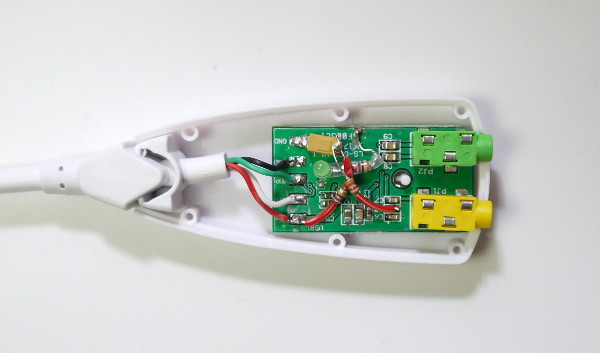
The NW-700 microphone works great with this modified sound card and it costs only a few cents
in materials. The output "phantom voltage" is 5V without any mic plugged. Under the load of
the condenser microphone it will go down a bit to around 4V but that is OK for the NW-700.
Sensitivity and sound quality are very good.
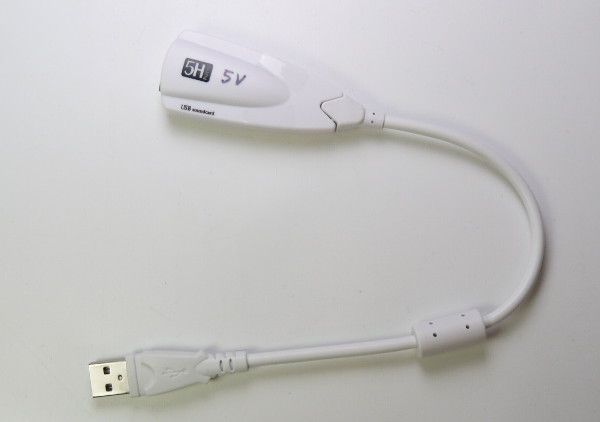
USB sound-cards with higher DC bias voltages
I did a survey of several USB sound cards prior do deciding to modify the card. I used
a digital voltmeter and measured the DC bias voltages on the mic port of the USB sound card.
In other words this is the max voltage with no load. I did not analyze how much the voltage goes
down under the load of the NW-700 Mic and what kind of internal pull-up resistor the cards use. It is however very likely
that all of them use around 3K Ohm for the pull-up resistor.
This bias voltages is very important for any condenser microphone and its sound quality, yet not a single USB sound-card specified this voltage on the package or the card itself. You have no way to know what the bias voltage is unless you take a voltmeter with you to the store.
- Most USB sound cards provide a DC voltage of 2.5V to 3V to the microphone.
- A few rare models provide 4.3V-4.5V DC:
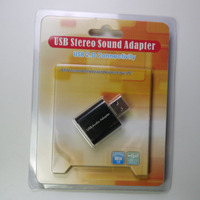
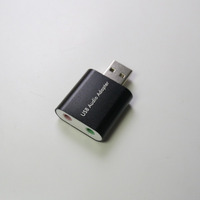
- Only my modified sound card provides about 5V DC.
It is possible to use the NW-700 condenser mic with cards that provide about 4.5V DC but
the quality of my modified card is still better. Computer gadgets that function already with lower voltages
can still be used on my modified sound card without suffering any damage. I did not find any
equipment that started to malfunction in combination with my modified card.
© 2004-2025 Guido Socher















